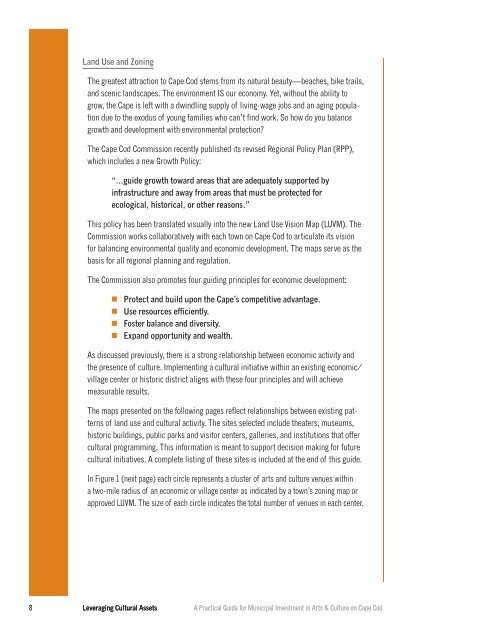Leveraging Cultural Assets for Economic Development - Cape Cod ...
Leveraging Cultural Assets for Economic Development - Cape Cod ...
Leveraging Cultural Assets for Economic Development - Cape Cod ...
- No tags were found...
You also want an ePaper? Increase the reach of your titles
YUMPU automatically turns print PDFs into web optimized ePapers that Google loves.
Land Use and ZoningThe greatest attraction to <strong>Cape</strong> <strong>Cod</strong> stems from its natural beauty—beaches, bike trails,and scenic landscapes. The environment IS our economy. Yet, without the ability togrow, the <strong>Cape</strong> is left with a dwindling supply of living-wage jobs and an aging populationdue to the exodus of young families who can’t find work. So how do you balancegrowth and development with environmental protection?The <strong>Cape</strong> <strong>Cod</strong> Commission recently published its revised Regional Policy Plan (RPP),which includes a new Growth Policy:“...guide growth toward areas that are adequately supported byinfrastructure and away from areas that must be protected <strong>for</strong>ecological, historical, or other reasons.”This policy has been translated visually into the new Land Use Vision Map (LUVM). TheCommission works collaboratively with each town on <strong>Cape</strong> <strong>Cod</strong> to articulate its vision<strong>for</strong> balancing environmental quality and economic development. The maps serve as thebasis <strong>for</strong> all regional planning and regulation.The Commission also promotes four guiding principles <strong>for</strong> economic development:n Protect and build upon the <strong>Cape</strong>’s competitive advantage.n Use resources efficiently.n Foster balance and diversity.n Expand opportunity and wealth.As discussed previously, there is a strong relationship between economic activity andthe presence of culture. Implementing a cultural initiative within an existing economic/village center or historic district aligns with these four principles and will achievemeasurable results.The maps presented on the following pages reflect relationships between existing patternsof land use and cultural activity. The sites selected include theaters, museums,historic buildings, public parks and visitor centers, galleries, and institutions that offercultural programming. This in<strong>for</strong>mation is meant to support decision making <strong>for</strong> futurecultural initiatives. A complete listing of these sites is included at the end of this guide.In Figure 1 (next page) each circle represents a cluster of arts and culture venues withina two-mile radius of an economic or village center as indicated by a town’s zoning map orapproved LUVM. The size of each circle indicates the total number of venues in each center.8<strong>Leveraging</strong> <strong>Cultural</strong> <strong>Assets</strong> A Practical Guide <strong>for</strong> Municipal Investment in Arts & Culture on <strong>Cape</strong> <strong>Cod</strong>
















